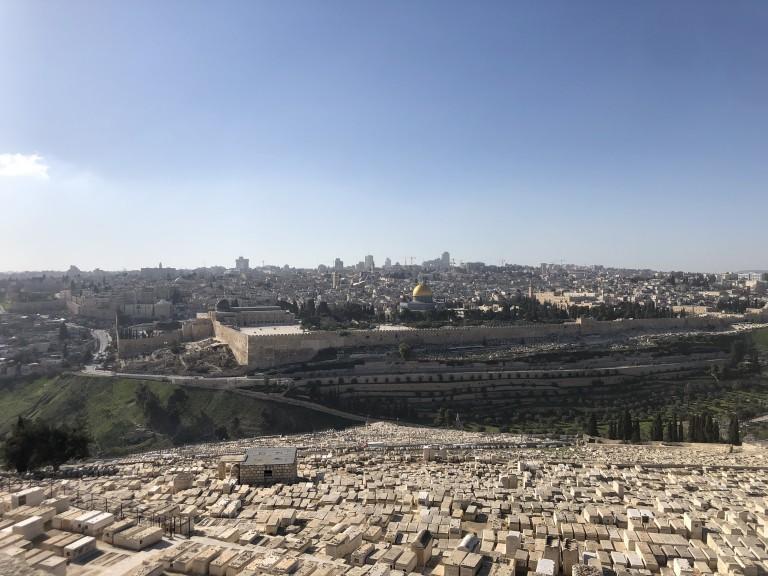There is a place in Jerusalem where the spirituality and faith of the three Abrahamic religions meet and compare peacefully. A Jewish, Christian and Muslim cemetery has been located between the slopes of the Cedron Valley and the Mount of Olives since ancient times.
The Jewish cemetery certainly arouses wonder and amazement in the visitor who arrives in Jerusalem for the first time: a myriad of white rectangles, a labyrinth of tombs extends on the side of the Mount of Olives overlooking Jerusalem. On the side opposite the Jewish cemetery, perched beneath the walls of the Holy City, are the Muslim tombs, ideally facing Mecca. At the bottom of the valley, the Christian cemetery, the tombs facing the Heavenly Jerusalem, which Christians also await at the end of days. The translation identifies the Cedron valley as the valley of Jehoshaphat, in Hebrew "the Judgement of God", the place where God will judge all his people at the end of time, on the day of the resurrection. For this reason, even today, many wealthy Jews still ask to be buried in this cemetery, with the hope that at the end of time, on the day of judgment, they will rise earlier than those who are buried elsewhere. According to Jewish tradition, the Messiah will come from the Golden Gate, today the only one of the eight gates of the city walls to be closed, to raise the dead.
For all these reasons, the valley and the mountain are dotted with tombs. Starting from below, in front of the Temple's pinnacle, you will find the tombs attributed to Absalon, Josaphat, the sons of Chezir and Zechariah and the youngest of Sadoc. What accumulates these tombs is the uncertainty of the owner. They are ancient tombs and mausoleums dated between the two centuries between the birth of Christ, which for their monumentality have impressed and interested scholars and pilgrims. Going up the valley, one arrives at the slopes of Gethsemane and the place where the Gerosolimitan tradition locates the tomb of Mary, mother of Jesus, from 450 AD. The discovery in an area by the Franciscans of the Custody of the Holy Land of a Roman-Byzantine necropolis of the 1st century AD with Christian ossuaries supports the thesis of Christian burials on the Mount.
Going further up the Dominus Flevit on the right, you come across the tombs of the prophets, a sepulchral complex dug into the rock with 36 tombs divided into two concentric semicircles. Some inscriptions in Greek suggest the burial of early Christians here too, and since the 17th century Islamic tradition indicates them as the tombs of three biblical prophets: Aggaeus, Zechariah and Malachi.
Less known is the last tomb we want to tell you about in this climb of the Mount of Olives. Next to the church of the Ascension, there is a singular tomb that the three religions curiously attribute to three different women. For the Jews it is the prophetess Hulda, mentioned in the Old Testament in the time of King Giosa. For the Muslims, it is the tomb of Rabi'a al Adawiyya, the one who introduced into ascetic Sufism in the 7th century the element of absolute divine love, the mother of Islamic spiritualism. According to Christian tradition, here is buried Pelagia, a prostitute, actress and dancer from Antioch, converted to Christianity by the Bishop of Edessa, who went to Jerusalem, dressed in men's clothing, to live as an ascetic monk on the Mount of Olives until her death, when her true identity was discovered.


















